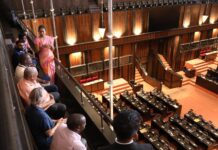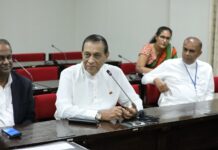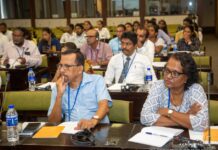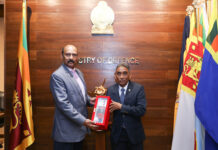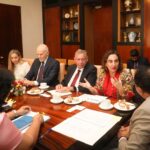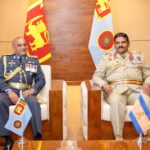
Chinese Ambassador to Colombo, Qi Zhenhong seems quite confident of Sri Lanka’s capacity to overcome the current economic turmoil the ruling Sri Lanka Podujana Peramuna (SLPP) is experiencing.
The top Chinese envoy, at an informal meeting with a selected group of print media journalists on Sunday, January 9, soon after the departure of Chinese State Councillor and Foreign Minister Wang Yi, asserted that the crisis was temporary. Ambassador Qi Zhenhong declared that as Sri Lanka had overcome far bigger challenges the country wouldn’t be overwhelmed by the current challenge in debt servicing.
The meet took place at the King Emperor Suite of the Galle Face Hotel.
Wang departed following high level political talks with the Sri Lankan leadership. President Gotabaya Rajapaksa, Premier Mahinda Rajapaksa and Chinese FM Wang inaugurated the Sri Lanka-China Sailing Cup 2022 at the Port City to celebrate the 65th anniversary of China and Sri Lanka diplomatic relations and the 70th anniversary of the Rubber-Rice pact.
Interestingly, former Premier and UNP leader Ranil Wickremesinghe, MP, was among the invitees. Wickremesinghe, whose government delayed the Port City project by about one and half years, sat next to Foreign Minister Prof. G. L. Peiris, who returned from an official visit to Seoul the previous day.
Is Ambassador Qi Zhenhong right in his assessment? Had there been far bigger crises in the recent past that threatened to overwhelm Sri Lanka? Perhaps Ambassador Qi Zhenhong is right in his appraisal. Maybe, he is not. Having joined the Chinese Foreign Service in 1988, Ambassador Qi Zhenhong took over the Chinese diplomatic mission in Colombo about a year ago at the height of Covid-19 eruption.
Amidst a simmering row with the Sri Lankan government over the rejection of an allegedly contaminated Chinese carbonic fertiliser consignment, Ambassador Qi Zhenhong undertook a three-day visit (Dec 15-17, 2021) to the Jaffna peninsula.
Colombo-based The Hindu correspondent, Meera Srinivasan, in a story dated Dec 26, 2021, headlined ‘Chinese Ambassador’s visit to Jaffna sparks concern, commentary in Sri Lanka’, described the visit as an intensification of geopolitical contest between India and China. Qi Zhenhong underscored China’s right to engage people in any part of Sri Lanka. Responding to media at the Emperor’s Suite, Qi Zhenhong pointed out, “Jaffna is in the northern part of Sri Lanka, not south of any other country”.
Ambassador Qi visited the Jaffna public library and the Adam’s Bridge, a row of limestone shoals across the narrow Palk Strait between Mannar and Rameswaram in Tamil Nadu.
The Ambassador visited a seafood factory in Mannar district, built with Chinese investment, and a sea cucumber farm in Jaffna.
The Chinese entry into Sri Lanka and the gradual expansion of its role here should be examined against the backdrop of Indian-funded terrorism project that destabilised the entire country.
The Sri Lanka Army couldn’t have withstood the terrorist firepower if not for military assistance provided by China, Pakistan, Russia and Israel during the early stages of the conflict.
Having paid a heavy price for destabilising its smaller neighbour, India allowed the annihilation of separatist Tamil conventional military capability in 2009. The eradication of terrorism has paved the way for geopolitical contest between the two Asian nuclear powers here.
Both China and India seemed confident in pursuing their agendas as the cash-strapped SLPP government struggled on multiple fronts. The deterioration of Sri Lanka’s economy as a result of the Covid-19 pandemic delivering a devastating blow to its once vibrant tourism industry and expatriate worker remittances, (both raked in huge amounts of foreign exchange), as well as waste, corruption and mismanagement at every level appeared to have facilitated anti-Sri Lanka foreign projects much to the dismay of the vast majority of people. Sri Lanka seems to be at the mercy of foreign powers.
Superpower politics
Chinese and Indian investments as well as relations with political parties here cannot be discussed leaving out the ongoing battle between China and the US-led grouping. India is part of the latter. South Korea is also in that group though it has so far refrained from joining the four-nation ‘Quad’ comprising the US, India, Japan and Australia. Post-war Sri Lanka is in a dicey situation. In spite of overcoming terrorism 12 years ago, Sri Lanka is under tremendous pressure from both parties as each seeks investment opportunities advantageous to them.
Recently, Fisheries Minister Douglas Devananda expressed concerns over China and India seeking to invest in the Point Pedro fisheries harbour. Devananda, the leader of the Eelam People’s Democratic Party (EPDP), one of the smaller terrorist groups, that took to the democratic path long before the LTTE terror mechanism was annihilated and primarily active in the Northern region vowed not to allow China to exploit the Northern population. Obviously Devananda is playing politics. The Fisheries Minister cannot take a view contrary to that of the Rajapaksas.
Pathfinder, an organisation founded by Sri Lanka’s High Commissioner in New Delhi, Milinda Moragoda, in its latest report titled ‘Sri Lanka has no room to maneuver’ carried in the January 10 edition of The Island warns of a catastrophe unless the government adopts remedial measures, immediately. While appreciating the arrangement Sri Lanka has reached with India to meet immediate challenges, Pathfinder recommended (i) restructuring of external debt (ii) an arrangement with the International Monetary Fund (iii) mobilisation of ‘bridging finance’ to meet the external financing gap up to June 2022.
Recent US and Indian investments in the energy sector should be viewed against the backdrop of much economically weakened Sri Lanka. The controversial energy deals with US-based New Fortress Energy, and Indian Oil Corporation Limited finalised on Sept 17, 2021 and January 5, 2022, respectively, generated much public interest.
The latter was finalised just days before the Chinese Foreign Minister’s visit. Both agreements have been challenged in the Supreme Court. The SC is in the process of hearing several petitions against the US energy deal whereas Ven. Wakmulle Uditha Thera of Nayigala Raja Mahaviharaya, Agrahara, Weeraketiya, filed a fundamental rights petition against the agreement on Trincomalee Oil Tank Farm. The Ven. Thera is believed to be acting on behalf of the JVP, the only party to move court against both the US and Indian investments.
Energy Minister Udaya Gammanpila, who along with Cabinet colleagues, Vasudeva Nanayakkara and Wimal Weerawansa moved SC against US energy deal that came through the backdoor, in a booklet titled ‘Regaining Trincomalee Oil Tank Farm’ declared that he gave the ‘strategic leadership’ to the project.
In spite of accusations of a sellout and betrayal by many quarters, including the Federation of National Organisations, led by Dr. Gunadasa Amarasekera, which demanded a thorough investigation. Attorney-at-law Gammanpila defended the latest agreement.
The booklet released by the Energy Ministry contained a letter dated July 29, 1987 signed by the then Indian Prime Minister Rajiv Gandhi that dealt with the Trincomalee oil tank farm, President JRJ’s response, an agreement finalised on Feb 7, 2003, during Ranil Wickremesinghe’s premiership, a Memorandum of Understanding (MoU) on economic projects signed in 2017 also during Wickremesinghe’s premiership.
What really surprised the public was that though the Energy Ministry compared the 2017 MoU with the recently finalised agreement, the ministry quite conveniently left the January 5 agreement out of the booklet. The ministry may claim that the agreement couldn’t be included as at the time of the releasing of the booklet, it hadn’t been signed. Perhaps, the printing of the booklet should have been delayed till the finalisation of the agreement.
Declaring the project received political guidance from President Gotabaya Rajapaksa and Prime Minister Mahinda Rajapaksa, the Energy Ministry revealed the identities of the two negotiating teams. Accordingly, the Sri Lankan delegation comprised Lalith Vidanagamage, Advisor, Energy Ministry, Buddhika Madihahewa, Managing Director, CPC, Mrs. Hasitha Paragahagoda, Legal Officer, Energy Ministry and Nalin Beligaswatta, Research Officer, Energy Ministry.
The Energy Ministry also named the Indian negotiating team. Deputy High Commissioner Vinod K. Jacob has led the Indian delegation that included Dr. Rakesh Pandey, Head of Commerce, Indian HC, Ms. Irina Thakur, First Secretary, Commerce and Cultural Affairs and Manoj Gupta, Managing Director, LIOC.
The Trincomalee Oil Tank Farm comprised two sections (i) Lower Tank Farm and (ii) Upper Tank Farm spread over 827 acres of land.
One cannot forget the circumstances India forced the Indo-Lanka Accord on the latter. That agreement finalised at the height of the US-Soviet cold war encompassed the Trincomalee Oil Tank Farm. Today, US-India relations have reached zenith whereas at the time of the Indo-Lanka Accord India was seen as being much closer to the Soviet Union and constantly feared the US using Sri Lanka as a platform to destabilise the country.
The letters exchanged between Rajiv Gandhi and JRJ agreed on the restoration and operation of the Trincomalee Oil Tank Farm as a joint venture.
With the latest agreement, India has consolidated its position in the strategic port city of Trincomalee close on the heels of politically influential Adani Group’s investment at the Colombo port. Gujarat-headquartered company signed a Build, Operate, Transfer (BOT) agreement with Sri Lanka’s largest listed company John Keells Holdings and the Sri Lanka Ports Authority (SLPA) to jointly develop the Colombo West International Container Terminal (CWICT) at the Colombo Port, situated amidst one of the busiest shipping routes in the world. China has secured a terminal of its own during the previous Rajapaksa administration as the war was raging with hardly any other investor showing interest and during the Yahapalana administration won a 99-year lease on the Hambantota port. Controversy surrounds the Hambantota port deal, too.
Arjuna Ranatunga, who had served as the Ports and Shipping Minister at that time had to give up the portfolio as he didn’t agree with the terms.
The then President Maithripala Sirisena and Premier Ranil Wickremesinghe brought in SLFPer Mahinda Samarasinghe as the Ports and Shipping Minister to put the finishing touches to it. Having finalised the agreement in 2017, Samarasinghe switched his allegiance to the SLFP in the run-up to the last parliamentary election in August 2020. The one-time UNPer recently gave up his Kalutara District parliamentary seat to receive appointment as Sri Lanka’s Ambassador in Washington.
Wijeyadasa strikes discordant note
In spite of China and Sri Lanka enjoying excellent relations and the latter regularly referring to China as an all-weather friend, there had been a number of contentious issues.
The Island had an opportunity to raise some of them with Ambassador Qi Zhenhong during last Sunday’s meeting. Reference was made to accusations made by the then Finance Minister Ravi Karunanayake as regards China taking advantage of Sri Lanka, dispute over contaminated carbonic fertiliser consignment that had to be settled by paying USD 6.7 mn to the Chinese firm concerned and SLPP lawmaker Wijeyadasa Rajapakse’s fiery letter to the Chinese President Xi Jinping.
There hadn’t been a previous instance of a lawmaker writing to the Chinese leader through its Ambassador in Colombo. Ambassador Qi Zhenhong dismissed Rajapakse’s concerns over China changing its strategy vis-a-vis Sri Lanka in the wake of the high profile ‘One Belt One Road’ (OBOR) project meant to improving connectivity and cooperation among multiple countries spread across the continents of Asia, Africa, and Europe. One-time Justice Minister and former President of the Bar Association of Sri Lanka (BASL) accused China of following an agenda intended to destroy Sri Lanka’s relations with the US, the UK, India, Japan, Korea, Australia and in time to come Russia.
Lawmaker Rajapakse’s stand cannot be examined without taking his call during the previous administration to rescind the Sri Lanka-China agreement on the Hambantota port through the intervention of the Parliament. That call was made in his capacity as a UNP Member of Parliament, whereas he wrote the January 3 dated letter as an SLPP lawmaker.
MP Rajapakse accused China of ruining Sri Lanka’s economy to facilitate their project. The former Justice Minister seemed to have no issue with Quad members, the UK and Korea. Quad members never stood by Sri Lanka at the Geneva-based United Nations Human Rights Council (UNHRC) whereas Western powers brazenly pursued a policy detriment to Sri Lanka.
They either voted against Sri Lanka or skipped the vote as in the case of Japan regardless of the Comprehensive Partnership the two countries entered into in Oct 2015. Obviously, Japan lacked the political will to go against the US wishes at the Geneva HRC, whereas Seoul voted against Colombo. On the basis of the Geneva process, the Sri Lankan military is being targeted by the US and some of her allies as part of the overall campaign directed at Sri Lanka.
Regardless of Sri Lanka’s close relations with China, the accusations made by MP Rajapakse cannot be dismissed lightly. The MP issued a warning over possible Chinese investments under the ‘Selendiva’ project, having questioned the investments on the Colombo Port, South Terminal, Coal-fired power plant complex at Norochcholai, International Airport at Mattala, Lotus Tower (Nelum Kuluna) in Colombo, Lotus Theatre (Nelum Pokuna) in Colombo, International Cricket Stadium at Suriyawewa and International Conference Hall in Hambantota. Alleging China created a debt trap, lawmaker Rajapakse said that he lost his portfolio during the Yahapalana administration as he opposed the Hambantota port deal.
The copies of MP Rajapakse’s explosive letter have been sent to the President, Prime Minister, Speaker, Most Venerable High Prelates, the Archbishop Colombo, Foreign Minister, Chinese Ambassador in Sri Lanka and Colombo-based High Commissioners and the Ambassadors of the other countries.
Can the SLPP government afford to ignore Wijeyadasa Rajapakse’s actions, particularly against the backdrop of stripping Susil Premjayantha of his portfolio over criticism of the government? Similarly, can Ministers Vasudeva, Wimal and Udaya get away after having challenged their Cabinet colleagues over the US energy deal? The government needs to address these issues as the ruling coalition as well as other political parties represented in Parliament struggle to come to terms with a rapidly changing situation. Avoiding Chinese as well as Western moves and that of India seem a herculean task for Sri Lanka, trying to walk the diplomatic tightrope.
During the Yahapalana administration, the US pushed for three agreements, namely ACSA (Access and Cross Servicing Agreement), SOFA (Status of Forces Agreement) and MCC (Millennium Challenge Corporation (MCC) Compact. On the approval of President Sirisena, the government signed ACSA in August 2017 though the remaining agreements couldn’t be finalised.
No one can forget how Premier Ranil Wickremesinghe authorised one-sided CFA (Ceasefire Agreement) or the Sirisena-Wickremesinghe duo allowed the Singapore Sri Lanka Free Trade Pact. If those in power and the Opposition are genuinely interested in protecting national assets, they’ll agree on a political mechanism to reach consensus on agreements with external powers/foreign parties.




